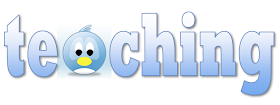We've been using
Twitter for about five months. We can't tell whether we are embarrassingly late to this near-universal social medium, or whether we are still ahead of the slow-to-change teacher curve. We're probably somewhere in the middle, and for us, that's a good thing. We are eager but judicious in latching on to new tools and trends (as anyone who has visited our straightforward
Facebook page knows). On
Twitter, we have benefited enormously from the innovative thinkers and generous sharers who have introduced us to eye-opening concepts, articles, and resources. In these few months, we've progressed professionally by leaps and bounds. Here are 10 ways that
Twitter has helped make us better teachers:
1. Recommended, pre-curated articles from trusted educators - The idea that a fellow teacher has sorted through a battery of blogs and publications to recommend only a few choice readings means that we can faithfully click on the links and reap the rewards of someone's curating. We're grateful for their hard work, which is why we keep following them. Their readings propose new ideas that we can incorporate into our instruction and share with our colleagues.
2. Links to terrific resources - In looking for online help, we always comment that we don't need lesson plans, we need resources. Web 2.0 tools and interactive sites offer dynamic ways to engage students and create projects. Through Twitter, we've been introduced to new web tools and have also gleaned helpful ideas for using them.
3. Wake-up calls about what we don't know and aren't doing - There is at once a soaring sensation and a sinking feeling when we realize all of the methods that are working successfully in America's classrooms and that we have not yet tried. School reform is a monstrous beast, and educational theory morphs in minutes. We try to keep up, but Twitter lets us know there is always more to learn. We stay motivated intellectually and keep improving professionally.
4. Tried and tested tips by respected professionals - Anytime someone recommends a new lesson or project, and then shares evidence about what worked well, we know we can successfully follow their lead in our own classrooms. Mimicking people we respect is the easiest form of professional development.
5. Important comparisons of challenges facing independent and public schools - Parochial, charter, independent, home-school, and public models all face similar difficulties in gauging achievement and motivating learners. But from there, the challenges branch in disparate directions when considering funding, testing, unionization, and leadership. As independent school teachers ourselves, we feel it is important to stay connected to the issues affecting all educators nationwide.
6. Confirmations about how much agreement there is among educators, and how much disagreement there is among administrators, parents, and politicians - Everyone we follow on Twitter seems to concur about creativity, play, projects, technology, collaboration, and problem-solving. Why do so many other voices fight against these proven influences? Why do so many forces crowd the teacher out of the classroom?
7. Revelations about real-life colleagues who are also on Twitter - It's neat to read what's on our friends' minds away from the daily hallways. We think we know our colleagues well, and then they surprise us with their reading lists, clever outbursts, and political leanings. Tracking their tweets, we know them anew.
8. Realizations about how funny the Twitterverse is - There are a lot of funny people out there. Who knew how witty teachers and Tweeters were? It's nice to laugh and learn at the same time.
9. Introductions to visually keen Twitter aggregators - Impressive tools such as
Paper.li and
Scoop.it! help
cull related ideas and offer them in imaginative, accessible layouts. Individuals can design self-published newsletters around particular areas of interest. Threads of hashtags help connect ideas. Check out
our daily Paper.li, about graphicacy and design in education.
10. Recognitions about Twitter's value to other social media - Social animals prowl freely. They know no cage. Every networking possibility links to readers and friends in other social media. If you're on Twitter, your blog,
Facebook page, and
LinkedIn profiles will all see upticks through their interconnectivity. Feed one, feed them all.

















